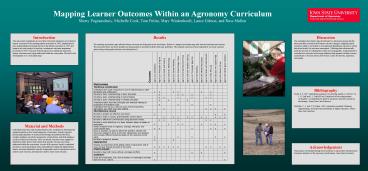Mapping Learner Outcomes Within an Agronomy Curriculum - PowerPoint PPT Presentation
1 / 1
Title:
Mapping Learner Outcomes Within an Agronomy Curriculum
Description:
Mapping Learner Outcomes Within an Agronomy Curriculum ... Mapping learner outcomes within a curriculum is one approach departments can use ... – PowerPoint PPT presentation
Number of Views:74
Avg rating:3.0/5.0
Title: Mapping Learner Outcomes Within an Agronomy Curriculum
1
Mapping Learner Outcomes Within an Agronomy
Curriculum Sherry Pogranichniy, Michelle Cook,
Tom Polito, Mary Wiedenhoeft, Lance Gibson, and
Russ Mullen
Introduction The Agronomy Department at Iowa
State University adopted a set of desired learner
outcomes for the undergraduate curriculum in
1992, implemented a new undergraduate curriculum
based on the learner outcomes in 1995, and began
a two-year project to develop a continuous
outcomes assessment procedure in 2002. One goal
of this project was to determine where the
learner outcomes were being addressed within the
curriculum. This led to the development of a
curriculum map.
Results
Discussion The completed curriculum map should
lead to a discussion among faculty about possible
curriculum and learner outcome changes. Mapping
learner outcomes within a curriculum is one
approach departments can use to collect data from
faculty for outcomes assessment. Collecting data
electronically made the process of collating the
results more manageable. Asking faculty to
consider how outcomes were being addressed and
measured in their courses caused them to be more
aware of how their course fits into the Agronomy
curriculum.
The resulting curriculum map indicates where
outcomes are being met in the curriculum. Below
is a sample curriculum map with selected outcomes
and courses. The outcomes below are those
students are being asked to document in their
electronic portfolios. The selected courses are
those required by our most common option along
with popular electives (in italicized text).
Bibliography Ewell, P. T. 1997. Identifying
indicators of curricular quality. p. 608-627. In
J. G. Gaff and J. L. Ratcliff (ed.) Handbook of
the undergraduate curriculum A comprehensive
guide to purposes, structures, practices, and
change. Jossey-Bass, San Francisco. Palomba, C.
A. and T. W. Banta. 1999. Assesment essentials
Planning, implementing, and improving assessment
in higher education. Jossey-Bass, San Francisco.
Material and Methods Individual interviews with
teaching faculty were conducted to determine the
emphasis placed on five broad categories of
outcomes. Faculty reported placing high emphasis
on technical knowledge and professional skills,
medium emphasis on holistic perspective of
agriculture, and little emphasis on ethics/values
and diversity. Next, the learner outcomes were
mapped to determine where and to what extent each
specific outcome was being addressed within the
curriculum. As part of this process, faculty
completed electronic course description forms
(spreadsheets) listing the departmental learner
outcomes addressed, specific assignments and/or
experiences used to achieve each outcome, and
measures used to assess each outcome.
Acknowledgement This project was funded through
the Excellence in Agronomic Education and
Extension Initiative of the Agronomy Endowment,
Iowa State University.































